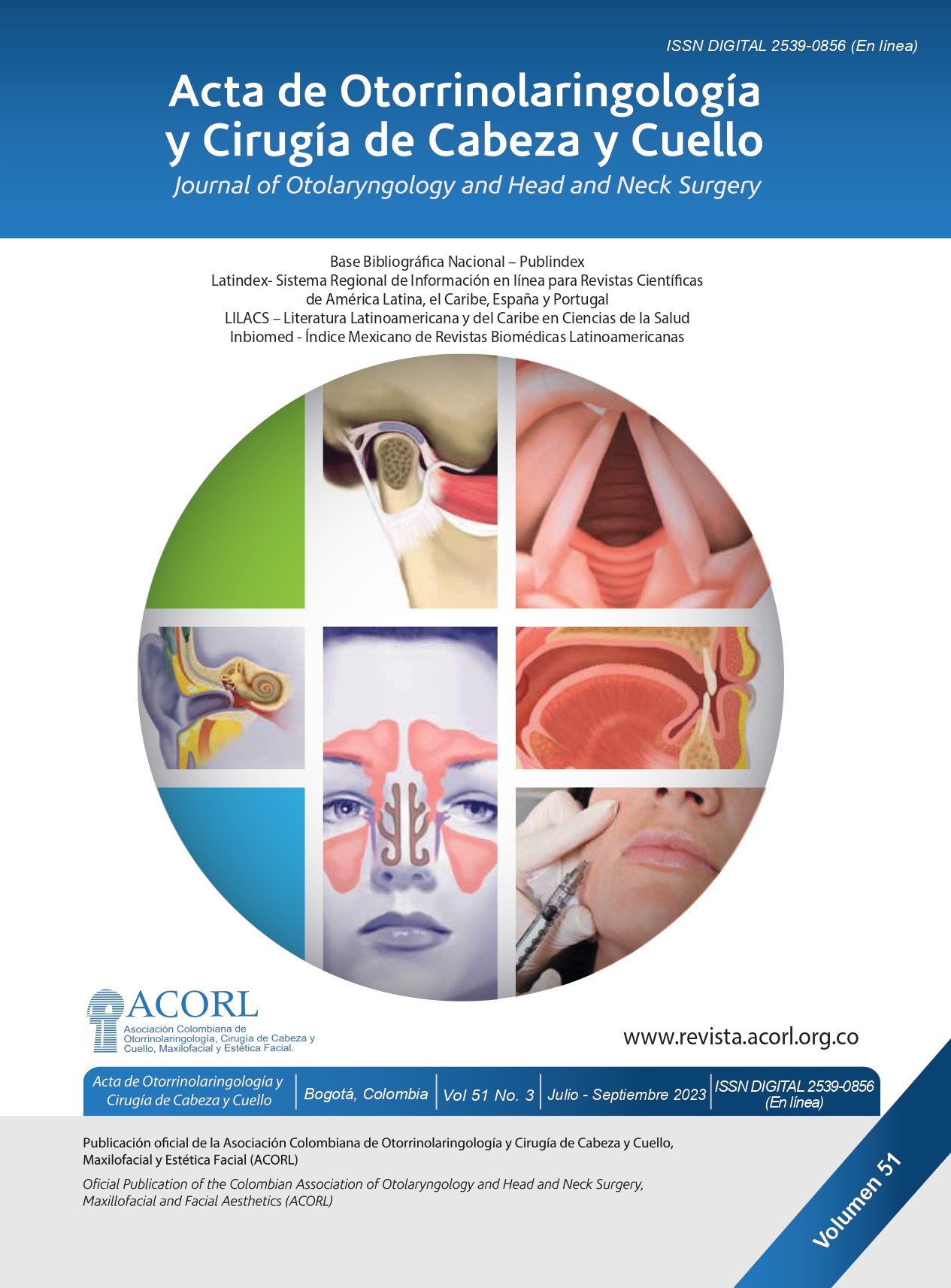Descripción de la frecuencia de factores de mala adherencia en la terapia con presión positiva en la vía aérea (CPAP-BPAP-APAP) en pacientes con AOS pertenecientes al Hospital Militar Central de Colombia entre 2015-2020
Contenido principal del artículo
Resumen
Introducción: la apnea obstructiva del sueño (AOS) es una enfermedad de etiología multifactorial. Existen diversos factores que condicionan la baja adherencia al manejo con sistemas de presión positiva desde problemas con el equipo hasta condiciones inherentes al paciente. El objetivo de este estudio es describir la frecuencia de los factores de mala adherencia reportados en la literatura en pacientes manejados entre 2015-2020. Metodos: estudio observacional, descriptivo, tipo serie de casos. Se realizó la revisión de historia clínica y diligenciamiento de una encuesta. Se caracterizaron y describieron las variables clínicas, físicas y relacionadas con el dispositivo. Resultados: se analizaron 26 pacientes, 76,9 % de sexo masculino y 23.1% de sexo femenino (23,1 %). La edad promedio de los pacientes era de 51,2 ± 13,2 anÞos. El índice de masa corporal (IMC) promedio fue de 27,8, de los cuales solo siete pacientes tenían un índice normal (<25; 26.9%). 10 pacientes al momento de la primera consulta no tenían somnolencia diurna (38,5 %). El índice de apnea-hipopnea (IAH) fue en promedio de 37,4/hora ± 17,5. Seis pacientes con presión de tratamiento menor o igual a 8 cmH2O (30 %) y 14 pacientes con presiones superiores (70 %). El promedio de IAH residual fue de 8,3 eventos/hora ± 10,1. Conclusiones: la frecuencia de factores relacionados con baja adherencia al tratamiento sugiere la necesidad de una valoración psicosocial exhaustiva del paciente, una historia clínica detallada y un examen físico completo con el fin de identificar limitantes para la adherencia al manejo y proporcionar estrategias terapéuticas.
Detalles del artículo
Sección

Esta obra está bajo una licencia internacional Creative Commons Atribución-CompartirIgual 4.0.
Este artículo es publicado por la Revista Acta de Otorrinolaringología & Cirugía de Cabeza y Cuello.
Este es un artículo de acceso abierto, distribuido bajo los términos de la LicenciaCreativeCommons Atribución-CompartirIgual 4.0 Internacional.( http://creativecommons.org/licenses/by-sa/4.0/), que permite el uso no comercial, distribución y reproducción en cualquier medio, siempre que la obra original sea debidamente citada.
eISSN: 2539-0856
ISSN: 0120-8411
Cómo citar
Referencias
Copur AS, Erik Everhart D, Zhang C, Chen Z, Shekhani H, Mathevosian S, et al. Effect of personality traits on adherence with positive airway pressure therapy in obstructive sleep apnea patients. Sleep Breath. 2018 May;22(2):369-76. doi: 10.1007/ s11325-017-1559-5
Chen YF, Hang LW, Huang CS, Liang SJ, Chung WS. Polysomnographic predictors of persistent continuous positive airway pressure adherence in patients with moderate and severe obstructive sleep apnea. Kaohsiung J Med Sci. 2015;31(2):83- 9. doi: 10.1016/j.kjms.2014.11.004
Akashiba T, Inoue Y, Uchimura N, Ohi M, Kasai T, Kawana F, et al. Sleep Apnea Syndrome (SAS) Clinical Practice Guidelines 2020. Respir Investig. 2022;60(1):3-32. doi: 10.1016/j.resinv.2021.08.010
Carrillo Alduenda JL, Arreondo del Bosque FM, Reyes Zúñiga M, Castorena Maldonado A, Vázquez García JC, Torre Bouscoulet L. Síndrome de apnea obstructiva del sueño en población adulta. Neumol Cir Torax. 2010;69(2):103-15.
Luo K, Zhang L, Zhang X, Han T, Li Y, Wang C. Acceptance of and six-month adherence to continuous positive airway pressure in patients with moderate to severe obstructive sleep apnea. Clin Respir J. 2021;15(1):56-64. doi: 10.1111/crj.13269
Bravata DM. Identifying predictors of adherence to positive airway pressure: the next step in implementing sleep apnea management for patients with cerebrovascular events. Sleep Med. 2020;66:241-42. doi: 10.1016/j.sleep.2020.01.005
Mehrtash M, Bakker JP, Ayas N. Predictors of Continuous Positive Airway Pressure Adherence in Patients with Obstructive Sleep Apnea. Lung. 2019;197(2):115-21. doi: 10.1007/s00408-018-00193-1
Picard F, Panagiotidou P, Weinig L, Steffen M, Tammen AB, Klein RM. Effect of CPAP therapy on nocturnal blood pressure fluctuations, nocturnal blood pressure, and arterial stiffness in patients with coexisting cardiovascular diseases and obstructive sleep apnea. Sleep Breath. 2021;25(1):151-61. doi: 10.1007/ s11325-020-02075-4
Drager LF, Malhotra A, Yan Y, Pépin JL, Armitstead JP, Woehrle H, et al. Adherence with positive airway pressure therapy for obstructive sleep apnea in developing vs. developed countries: a big data study. J Clin Sleep Med. 2021;17(4):703- 9. doi: 10.5664/jcsm.9008
Engleman HM, Wild MR. Improving CPAP use by patients with the sleep apnoea/hypopnoea syndrome (SAHS). Sleep Med Rev. 2003;7(1):81-99. doi: 10.1053/smrv.2001.0197
Catcheside PG. Predictors of continuous positive airway pressure adherence. F1000 Med Rep. 2010;2:70. doi: 10.3410/ M2-70
McArdle N, Devereux G, Heidarnejad H, Engleman HM, Mackay TW, Douglas NJ. Long-term use of CPAP therapy for sleep apnea/hypopnea syndrome. Am J Respir Crit Care Med. 1999;159(4 Pt 1):1108-14. doi: 10.1164/ajrccm.159.4.9807111
Nino-Murcia G, McCann CC, Bliwise DL, Guilleminault C, Dement WC. Compliance and side effects in sleep apnea patients treated with nasal continuous positive airway pressure. West J Med. 1989;150(2):165-9.
Hoffstein V, Viner S, Mateika S, Conway J. Treatment of obstructive sleep apnea with nasal continuous positive airway pressure. Patient compliance, perception of benefits, and side effects. Am Rev Respir Dis. 1992;145(4 Pt 1):841-5. doi: 10.1164/ajrccm/145.4_Pt_1.841
Sawyer AM, Gooneratne NS, Marcus CL, Ofer D, Richards KC, Weaver TE. A systematic review of CPAP adherence across age groups: clinical and empiric insights for developing CPAP adherence interventions. Sleep Med Rev. 2011;15(6):343-56. doi: 10.1016/j.smrv.2011.01.003
Van Ryswyk E, Anderson CS, Antic NA, Barbe F, Bittencourt L, Freed R, et al. Predictors of long-term adherence to continuous positive airway pressure in patients with obstructive sleep apnea and cardiovascular disease. Sleep. 2019;42(10):zsz152. doi: 10.1093/sleep/zsz152
Zampogna E, Spanevello A, Lucioni AM, Facchetti C, Sotgiu G, Saderi L, et al. Adherence to Continuous Positive Airway Pressure in patients with Obstructive Sleep Apnoea. A ten year real life study. Respir Med. 2019;150:95-100. doi: 10.1016/j. rmed.2019.02.017
Weaver TE. Novel Aspects of CPAP Treatment and Interventions to Improve CPAP Adherence. J Clin Med. 2019;8(12):2220. doi: 10.3390/jcm8122220
Aalaei S, Rezaeitalab F, Tabesh H, Amini M, Afsharisaleh L, Mostafavi SM, et al. Factors Affecting Patients’ Adherence to Continuous Positive Airway Pressure Therapy for Obstructive Sleep Apnea Disorder: A Multi-Method Approach. Iran J Med Sci. 2020;45(3):170-78. doi: 10.30476/ijms.2019.45785





